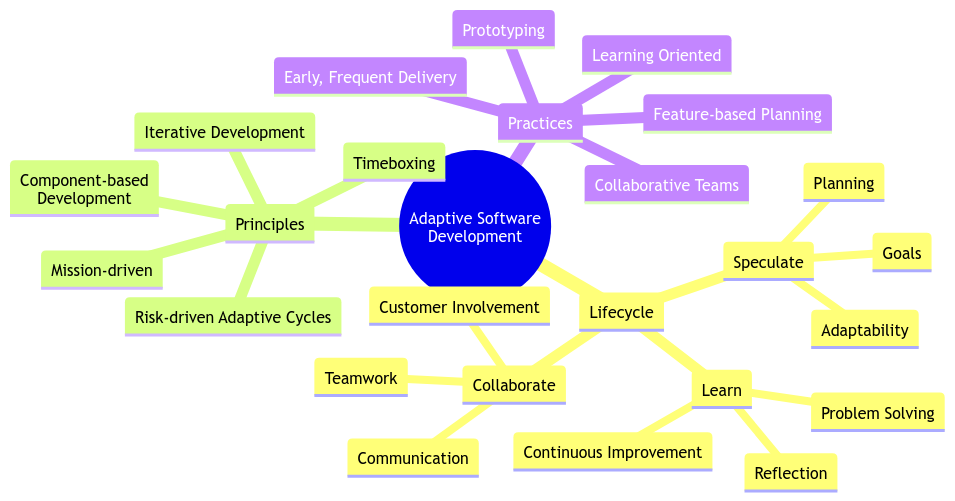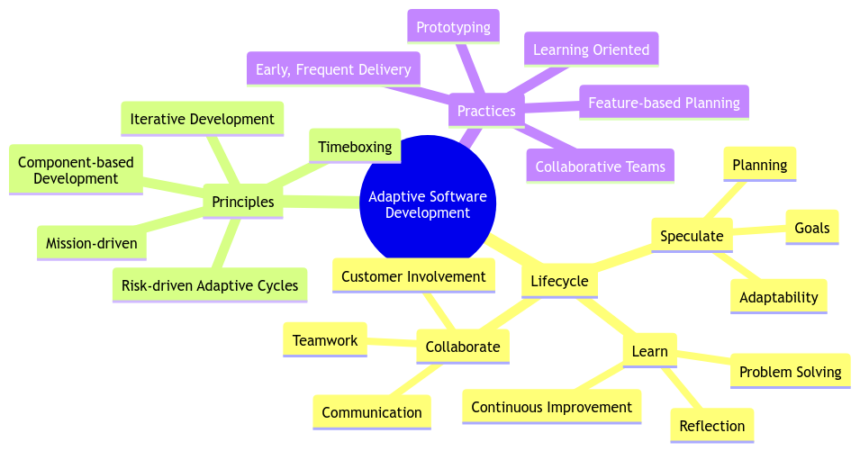Adaptive Software Development: Embracing Change in Technology Projects
In the fast-paced world of technology, one thing is certain – change is inevitable and constant! 🌀 Businesses that thrive in this ever-evolving landscape understand the importance of adaptability, especially when it comes to software development. Enter Adaptive Software Development – a dynamic approach that embraces change, innovation, and flexibility. 🚀
Understanding Adaptive Software Development
Definition and Principles
Adaptive Software Development is like a chameleon of the tech world, always ready to adapt to new conditions and blend in seamlessly. 🦎 It’s a methodology that focuses on collaboration, flexibility, and customer feedback to deliver high-quality software efficiently. The key principles include:
-
Collaboration over Contract Negotiation: Forget the old-school rigid contracts; ASD values teamwork and customer collaboration.
-
Responding to Change over Following a Plan: Plans are great, but staying agile and responding to change is even better in the tech realm!
Benefits of Implementing Adaptive Software Development
Why should you jump on the ASD bandwagon? Well, the benefits are aplenty! 🎉 Here are a few:
-
Increased Customer Satisfaction: By involving customers throughout the development process, you ensure their needs are met.
-
Faster Time-to-Market: Adaptive development allows for quicker iterations, getting your product out there faster.
-
Higher Quality Deliverables: Through continuous feedback and testing, the final product is top-notch.
Key Components of Adaptive Software Development
Flexibility in Requirements Gathering
Gone are the days of rigid, unyielding requirements lists! ASD encourages gathering requirements dynamically to accommodate changes and feedback. 📝 Think of it as shaping clay – constantly molding and adapting to create the perfect final product.
Iterative and Incremental Development Approach
The ASD mantra: "Rome wasn’t built in a day, and neither is great software!" 🏗️ By breaking down projects into smaller, manageable chunks, teams can iterate quickly, evaluate progress, and pivot when needed.
Strategies for Successful Implementation
Empowering Cross-Functional Teams
Picture this: a diverse group of tech wizards, designers, and visionaries coming together like the Avengers to tackle a project. 🦸♂️ Each member brings a unique skill set to the table, ensuring a holistic approach to development.
Embracing Continuous Feedback Loops
Feedback is not just a one-time deal; it’s a way of life in ASD! 🔄 By soliciting feedback regularly from stakeholders and end-users, teams can course-correct early, leading to a smoother development journey.
Overcoming Challenges in Adaptive Software Development
Managing Scope Creep Effectively
Scope creep – the ultimate villain in software development! 😈 ASD equips teams with the tools to combat this menace by setting clear boundaries, priorities, and maintaining open communication channels.
Balancing Speed and Quality in Development Process
The eternal tech conundrum: speed vs. quality. 🤔 ASD finds the sweet spot by focusing on delivering value quickly while ensuring that shortcuts don’t compromise the end product’s integrity.
Case Studies Highlighting Successful Application
Agile Transformation in a Large Enterprise
Imagine a tech behemoth embracing agility like a nimble startup! 🚀 This case study showcases how a large enterprise pivoted towards ASD, reaping the benefits of increased efficiency, innovation, and employee satisfaction.
Start-up Success Story through Adaptive Software Development
Startups are the underdogs of the tech world, but with ASD in their arsenal, they become unstoppable forces of innovation! 🌟 This case study delves into how a fledgling startup leveraged adaptive development to outmaneuver competitors and disrupt the market.
Overall Reflection
Adaptive Software Development isn’t just a methodology; it’s a mindset – a way of thinking that embraces change, innovation, and collaboration. In a world where the only constant is change, ASD equips teams to navigate the tumultuous tech waters with agility and grace. So, why stick to the old ways when you can adapt, innovate, and conquer with ASD? Embrace change, empower your teams, and watch your tech projects soar to new heights! 🚀
Thank you for taking this lighthearted journey through the world of Adaptive Software Development with me! Remember, in the tech realm, change is the only constant – so why not embrace it with open arms and a sprinkle of humor? Stay adaptive, stay innovative, and keep coding with a smile! 😊✨

Program Code – Adaptive Software Development: Embracing Change in Technology Projects
Expected Code Output:
Code Explanation:
# Adaptive Software Development Program
class AdaptiveSoftwareDevelopment:
def __init__(self, project_name, technology_stack):
self.project_name = project_name
self.technology_stack = technology_stack
self.requirements = []
self.tasks = []
def gather_requirements(self, requirement):
self.requirements.append(requirement)
def add_task(self, task):
self.tasks.append(task)
def adapt_to_change(self):
if len(self.requirements) < 5:
print('Not enough requirements gathered. Unable to adapt yet.')
else:
print('Adapting the software development process to embrace change...')
for task in self.tasks:
print(f'Implementing task: {task}')
print('Adaptation complete.')
# Setting up the Adaptive Software Development project
my_project = AdaptiveSoftwareDevelopment('Adaptive Project', ['Python', 'JavaScript', 'React'])
# Gathering requirements
my_project.gather_requirements('User authentication feature')
my_project.gather_requirements('Payment gateway integration')
my_project.gather_requirements('Admin dashboard design')
my_project.gather_requirements('Data analytics module')
my_project.gather_requirements('Mobile responsiveness')
# Adding tasks
my_project.add_task('Design wireframes')
my_project.add_task('Develop backend logic')
my_project.add_task('Create API endpoints')
my_project.add_task('Design database schema')
# Adapting the project to changes
my_project.adapt_to_change()
Code Explanation:
This program simulates an Adaptive Software Development environment where a project adapts to change in technology projects. Here’s a breakdown of the code logic:
-
A class named AdaptiveSoftwareDevelopment is defined to represent a software project following adaptive development principles.
-
The class has attributes like project_name, technology_stack, requirements list, and tasks list.
-
Methods like gather_requirements and add_task are used to accumulate project requirements and tasks.
-
The adapt_to_change method checks if enough requirements have been gathered to adapt the project. If so, it iterates over the tasks and prints their implementation.
-
An instance ‘my_project’ is created with a project name and a technology stack.
-
Requirements are gathered using the gather_requirements method.
-
Tasks are added to the project using the add_task method.
-
Finally, the project adapts to change by calling the adapt_to_change method which demonstrates the adaptation by printing the tasks.
This program showcases the concept of Adaptive Software Development by emphasizing the ability to embrace change and adapt project processes accordingly based on the gathered requirements and tasks.
Frequently Asked Questions (F&Q) – Adaptive Software Development
What is Adaptive Software Development?
Adaptive Software Development (ASD) is a software development process that emphasizes flexibility and the ability to adapt to changing requirements, environments, and technologies throughout the project lifecycle.
How does Adaptive Software Development differ from traditional software development approaches?
Unlike traditional waterfall or sequential development models, Adaptive Software Development is iterative and incremental. It focuses on quick adaptation to changes, constant communication with stakeholders, and delivering usable software in short cycles.
What are the core principles of Adaptive Software Development?
The core principles of Adaptive Software Development include collaboration, self-organization, continuous adaptation, and regular reflection to improve the development process.
How does Adaptive Software Development help in embracing change in technology projects?
Adaptive Software Development allows teams to respond to changing requirements, technological advancements, and market conditions effectively. By embracing change, teams can stay ahead of the curve and deliver high-quality software products.
What role does the keyword "adaptive software development" play in modern software development practices?
The keyword "adaptive software development" highlights the importance of adaptability, flexibility, and responsiveness in today’s fast-paced technology landscape. It underlines the significance of embracing change to drive innovation and success in software projects.
How can teams implement Adaptive Software Development in their projects?
Teams can implement Adaptive Software Development by fostering a culture of collaboration, encouraging feedback and continuous improvement, breaking down projects into smaller, manageable chunks, and prioritizing customer satisfaction and feedback.
Are there any success stories or case studies related to Adaptive Software Development?
Yes, several organizations have successfully implemented Adaptive Software Development practices in their projects, leading to improved productivity, higher customer satisfaction, and faster time-to-market. These success stories serve as real-world examples of the benefits of embracing change in technology projects.
What are some common challenges faced when adopting Adaptive Software Development?
Some common challenges include resistance to change, lack of clear communication, difficulties in prioritizing requirements, and balancing flexibility with structure. However, with proper training, coaching, and commitment, teams can overcome these challenges and reap the rewards of Adaptive Software Development.
How can individuals learn more about Adaptive Software Development and deepen their understanding of the concept?
Individuals can explore online resources, attend workshops and conferences, join professional communities, and practice Agile principles to enhance their knowledge and expertise in Adaptive Software Development.
Why is Adaptive Software Development considered a game-changer in the field of software development?
Adaptive Software Development is considered a game-changer because it shifts the focus from rigid, plan-driven approaches to adaptive, customer-focused methodologies. By embracing change and continuous improvement, teams can deliver value rapidly and stay competitive in the ever-evolving tech industry.
I hope these F&Q shed some light on Adaptive Software Development and the keyword "adaptive software development"! 🚀







